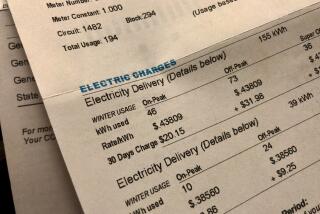Edison Posts Losses for Quarter, Year
Edison International on Tuesday joined its partner in deregulation dysfunction, PG&E; Corp., in declaring a huge write-off of electricity and other costs. That resulted in large net and operating losses at the Rosemead-based company for the fourth quarter and all of 2000.
But both utility parents continued to hold out hope that they would eventually recover those costs and return their ailing balance sheets to good health. PG&E;, whose utility arm Pacific Gas & Electric Co. filed for bankruptcy law protection April 6, posted its results Monday; both companies delayed their filings by two months because of the uncertainty surrounding their financial predicaments.
In stark contrast, in the last two day, several electricity suppliers to Californiaâs gold-plated power market reported sharply higher earnings for the first quarter.
Together, the earnings statements provide a handy scorecard of who has won and who has lost in the crisis that has sizzled through the stateâs electricity business in the last year.
Electricity suppliers âcertainly are doing well,â said Douglas Christopher, utility analyst with Crowell, Weedon & Co. âIf you control the source of supply, you control a lot.â
Consumer advocate Michael Shames sounded a darker note.
âDollars are flowing out of the state at an accelerated rate,â said Shames, executive director of the Utility Consumersâ Action Network in San Diego. âItâs leaving the utilities and flowing right into the hands of the energy suppliers. They canât lose. The contrast is disgusting.â
As expected, Edison International took a $4.2-billion pretax charge against earnings, which translated into $2.5 billion after taxes.
The charge primarily reflected debts the companyâs beleaguered Southern California Edison subsidiary piled up last year as wholesale electricity prices skyrocketed and the utility was unable to charge customers all that it paid for power because of a retail rate freeze.
Edison said it took the charge because of a recent decision by the California Public Utilities Commission that forced Edison and PG&E; to recalculate electricity- and deregulation-related debt to include past profit earned during the first two years of deregulation, when wholesale costs were lower than retail rates.
That charge resulted in net losses for Edison International of $2.5 billion, or $7.83 per share, for the fourth quarter and $1.9 billion, or $5.84 per share, for the year. In 1999, the company posted net income of $96 million for the fourth quarter and $623 million for the year.
Edison posted a fourth-quarter operating loss of $3.8 billion, versus operating income of $326.9 million in 1999. Operating loss for 2000 was $1.73 billion, compared with operating income of $1.75 billion in 1999.
Excluding the electricity write-off, Edison International would have earned $578 million for 2000; Southern California Edison would have earned $471 million in 2000 without the write-off, versus $484 million in 1999.
âTodayâs financial charge, painful as it is for the company, only recognizes the well-known reality of SCEâs large, unreimbursed costs of serving its customers,â said John E. Bryson, chairman and chief executive of Edison International. âWhat is important now, however, is not so much compliance with accounting rules but whether Edison ultimately has a path to recover its costs.â
Edison executives said the agreement it signed last week with Gov. Gray Davis, if enacted by the state Legislature and the PUC, would allow the company to recover most of the costs it wrote off Tuesday. The agreement would allow for the sale of Edisonâs transmission grid to the state for $2.76 billion as well as for the sale of revenue bonds to help repay debt.
Only âprompt implementationâ of the agreement, Bryson warned, âcan avoid the large costs of an SCE bankruptcy and make it possible for the company to restore its financial health and ability to maintain a reliable power grid.â
Legislators have been grousing about the agreement, raising fears that passage might not be smooth.
âThis is not a slam dunk,â said Brian Youngberg, senior utility analyst for the Edward Jones investment firm in St. Louis. âIf everything falls into place, they may well recover a large portion of the charge. But if it doesnât, all bets are off.â
Bankruptcy, whether voluntary or forced, remains a possibility, he said.
Consumer activists have opposed the agreement as a bailout by the state.
âI have very little sympathy for the utilities,â said Mindy Spatt, media director for the Utility Reform Network in San Francisco. âThey supported the deregulation of rates. They made their bed; now they have to lie in it.â
Several electricity suppliers to California reported gigantic earnings surges for the quarter ended March 31:
* Duke Energy Corp. of Charlotte, N.C., saw a 63% increase in first-quarter operating profit, jumping to $554 million from $339 million a year ago.
* Houston-based Dynegy Inc. said its operating income increased 40%, improving to $255 million in the first three months of 2001 from $182 million a year earlier.
* Enron Corp. of Houston, which owns no power plants in California but is the worldâs biggest buyer and seller of electricity and natural gas, said it posted operating income of $406 million in the first quarter, compared with $338 million in the same period last year, a 20% increase.
* Reliant Energy, another Houston energy conglomerate, said Monday that operating profit for the first quarter rose 35%, to $460 million from $341 million in the year-ago quarter.
Carol Coale, an analyst with Prudential Securities Inc. in Houston, said increased demand for electricity and natural gas in California and the rest of the country fueled the earnings increases.
âClearly, the California energy crisis has raised the bar on those power and gas trading and marketing profits,â Coale said. âOpportunities have existed outside California as well.â
But the companies all took great pains to note that California operations were only a small part of their businesses. Dynegy President Steve Bergstrom said the company has been âunfairly and inaccurately accused of withholding power from the California marketâ to drive up prices and profit.
When asked about big profits at electricity suppliers, Edison Chief Financial Officer Ted Craver quipped: âWeâre envious.â But he quickly turned serious, declining to comment on whether the generators were profiting at the utilityâs expense.
âThis is very, very serious business for us,â Craver said, noting that the company could take further charges that âcould completely extinguish our equity at the utility.â
But the utilities are not the only companies facing possibly lowered expectations, because a political or regulatory backlash could eventually hinder future profit for generators as well.
âThis free lunch is not going to last forever,â utility analyst Christopher said.
Edison International shares gained 3 cents to close at $11.88 on the New York Stock Exchange; the stock remains well off its 52-week closing high of $26.13 on Sept. 13.
The generatorsâ stocks have generally fared well as the broader market has declined. In trading Tuesday, all gained on the NYSE: Duke closed $2.09 higher at $44.60 a share; Dynegy rose $2.80 to $55.95; Enron gained 56 cents to $60; and Reliant was up $1.92 to $48.92.
*
Associated Press was used in compiling this report.
(BEGIN TEXT OF INFOBOX / INFOGRAPHIC)
Shifting Fortunes for Energy Players
Financial results reported this week by Californiaâs two major utilities and by out-of-state energy companies that supply them show the dramatic shift in fortunes in the power business over the last year.
*
*
PG&E; in 2000
-$4.1 billion
*
Edison in 2000
-$2.5 billion
*
. . . While Their Suppliers Boom
Operating income for key energy suppliers, in millions of dollars, first quarter of 2001 versus first quarter of 2000:
*
Sources: Company filings, Bloomberg News, Times research
Researched by NONA YATES and TOM PETRUNO/Los Angeles Times
More to Read
Inside the business of entertainment
The Wide Shot brings you news, analysis and insights on everything from streaming wars to production â and what it all means for the future.
You may occasionally receive promotional content from the Los Angeles Times.










